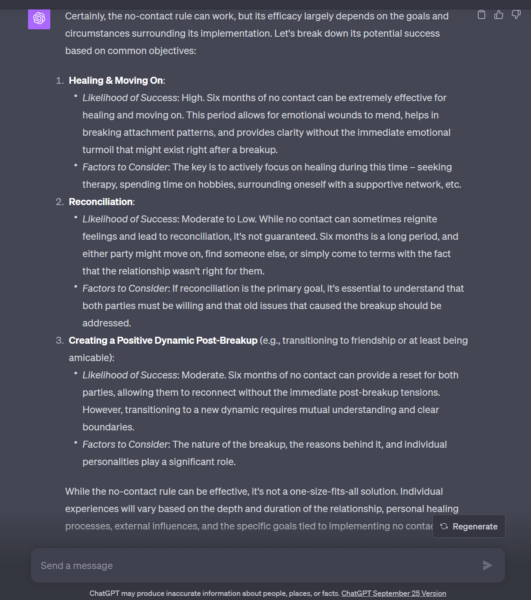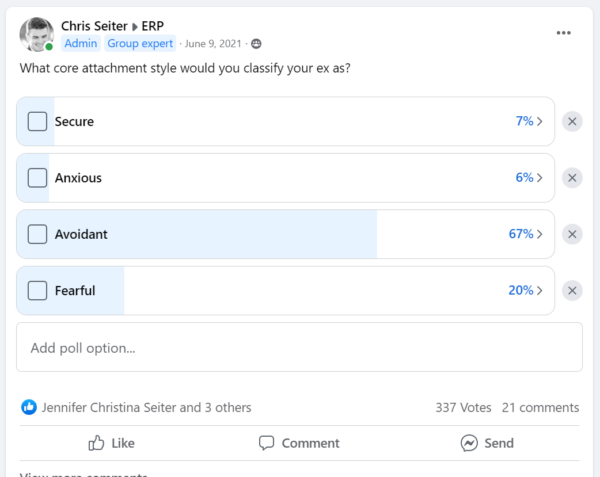Today we’re going to look at if the no contact rule can work after 6 months go by.
Half a year.
Ultimately I think the answer sort of depends on how you personally define a no contact rule “working.”
- Are you looking to get over an ex?
- Get them back?
- Maintain a friendship?
Each one of these probably has a different answer.
AND…. to prove that point I wanted to see what AI thought. After all, AI is supposedly taking over my job, right? Let’s see how it did.

What Are Your Chances of Getting Your Ex Boyfriend Back?
Take the quizI Actually Think AI Got This One Right (Except…)
So, I went to chat GPT and asked it the following, Can No Contact Work After Six Months?
Here’s what it said,
Certainly, the no-contact rule can work, but its efficacy largely depends on the goals and circumstances surrounding its implementation. Let’s break down its potential success based on common objectives:
1. Healing & Moving On:
- Likelihood of Success: High. Six months of no contact can be extremely effective for healing and moving on. This period allows for emotional wounds to mend, helps in breaking attachment patterns, and provides clarity without the immediate emotional turmoil that might exist right after a breakup.
- Factors to Consider: The key is to actively focus on healing during this time – seeking therapy, spending time on hobbies, surrounding oneself with a supportive network, etc.
2. Reconciliation:
- Likelihood of Success: Moderate to Low. While no contact can sometimes reignite feelings and lead to reconciliation, it’s not guaranteed. Six months is a long period, and either party might move on, find someone else, or simply come to terms with the fact that the relationship wasn’t right for them.
- Factors to Consider: If reconciliation is the primary goal, it’s essential to understand that both parties must be willing and that old issues that caused the breakup should be addressed.
3. Creating a Positive Dynamic Post-Breakup (e.g., transitioning to friendship or at least being amicable):
- Likelihood of Success: Moderate. Six months of no contact can provide a reset for both parties, allowing them to reconnect without the immediate post-breakup tensions. However, transitioning to a new dynamic requires mutual understanding and clear boundaries.
- Factors to Consider: The nature of the breakup, the reasons behind it, and individual personalities play a significant role.
While the no-contact rule can be effective, it’s not a one-size-fits-all solution. Individual experiences will vary based on the depth and duration of the relationship, personal healing processes, external influences, and the specific goals tied to implementing no contact.
For many, the rule serves as a valuable tool in the post-breakup recovery process, ensuring they give themselves the time and space necessary to heal, grow, and reflect. However, for others, especially if there are misconceptions about guaranteed outcomes (like assured reconciliation), it can lead to disappointment.
In conclusion, while the no-contact rule can work based on specific objectives, it’s crucial for individuals to have clear intentions and realistic expectations when implementing it.
The AI Really Hints On The Ticking Clock That Exists If You Want Your Ex Back
The AI astutely points to the ticking clock that comes into play if you hope to reconcile with your ex.
Given that I primarily assist individuals eager to win their exes back, I feel compelled to discuss the efficacy of the no-contact rule after a 6-month period, especially in the context of reconciliation.
It’s crucial to understand that reconciliation isn’t an open-ended opportunity. The moment a breakup occurs, whether initiated by you or your ex, a timer begins. While its exact duration remains elusive, its existence is undeniable.
A cursory observation of relationships around us provides ample evidence: some individuals may remain fixated on past relationships for years, but a significant majority move on within a few months to a couple of years.
Therefore, I concur that a 6-month hiatus may have depleted much of the time you had.
Looking At Our Success Statistics
In terms of success metrics, the average testimonial from our program emerges between 5 to 7 months after clients begin their journey with us.

What Are Your Chances of Getting Your Ex Boyfriend Back?
Take the quizMost of these clients approach us within a month of their breakup. Therefore, by the time the majority of our clients successfully reconcile, you’d only be initiating your no-contact phase.
This implies you’re considerably behind. Indeed, starting your no-contact rule after six months might be too late. This very notion underpins my staunch stance on alerting clients about the risks of breaking the no-contact rule and consequently having to reinitiate it. Such interruptions not only diminish the strategy’s potency but also further deplete the available time.
While it’s hard to pinpoint the exact duration it would take for your ex to move on entirely, consider this:
On average, breaking a habit takes anywhere from 66 to 75 days.
Hypothetically, your ex could cease their preoccupation with you within 66 days. While this scenario is unlikely, it serves as a reminder of the ticking clock. As the AI suggests, this time constraint is real and pressing.
However, it’s worth noting that exceptions always exist..
Fails To Take Into Account The Phantom Ex Scenario We See Play Out
I believe the AI overlooks the phenomenon of the “phantom ex” scenario that we frequently observe.
Most exes we study exhibit dismissive avoidant behaviors.
What’s fascinating about dismissive avoidance is that these individuals typically don’t allow themselves to miss you until they perceive you as out of reach or out of a relationship – only when they feel safe in missing you.
I’ve discussed this in depth in one of my videos. Such individuals often view their ex as the “phantom ex” or the “one that got away,” preferring to reminisce from a distance where there’s no immediate commitment risk.
The primary distinction between avoidant and anxious individuals lies in their values. While avoidants prize their independence, often fleeing or breaking up when they sense their independence is threatened, anxious types fear abandonment.
These contrasting styles are like oil and water, continually setting each other off. I’ll delve deeper into this shortly.
How often have stories emerged of exes reaching out just when you’ve moved on, sometimes even years later?
They’re merely checking in, gauging how you’re doing. This behavior exemplifies the “phantom ex” scenario.
The ex, feeling no commitment pressure, begins to romanticize and look back fondly.
Interestingly, in one of the initial episodes of my podcast, I addressed a question from a woman whose ex, after a year’s gap, reconnected to ask her on a date. This is the “phantom ex” scenario in action. The AI might not fully grasp this dimension.
My Answer On If No Contact Can Work After 6 Months
Where do I stand on the effectiveness of the no-contact rule after six months? I believe it can work.
However, echoing the AI, the likelihood is slim.
Six months is substantial, and time is running its course.
That said, factors could enhance your chances.
- If, during the six months post-breakup, you maintain contact with your ex, sharing flirtatious exchanges and everything seems relatively positive, the no-contact rule could prove effective.
- Conversely, if you’ve spent those months in heightened anxiety, constantly seeking reassurance and closure, the scenario becomes more challenging. These behaviors might reaffirm to your ex your anxious attachment tendencies, solidifying their decision to part ways and potentially seek companionship elsewhere. Hence, I concur with the AI; the chances are indeed moderate to low.


Ian
August 20, 2024 at 12:08 pm
Ex dumped me 6wks ago, for the first 4wks I begged then was angry, she is in new relationship. Its been 2weeks no contact, any hope?